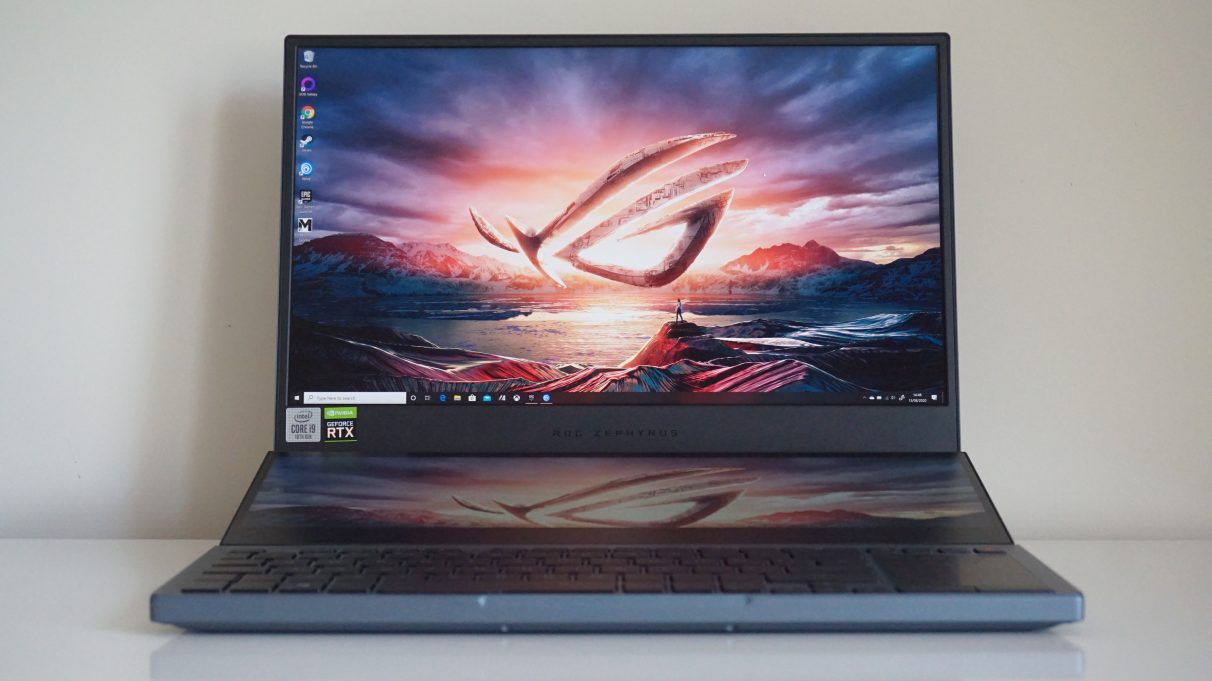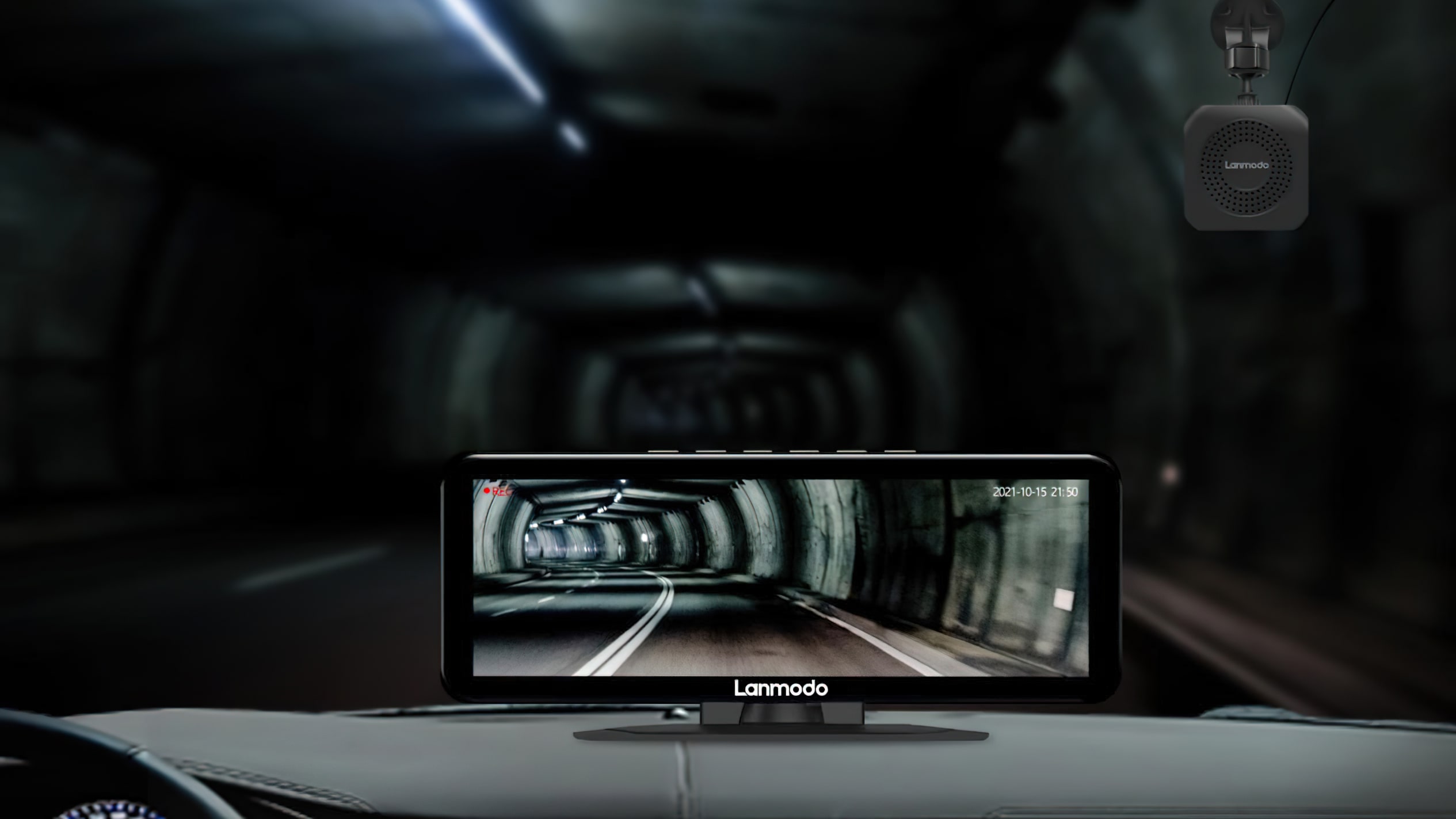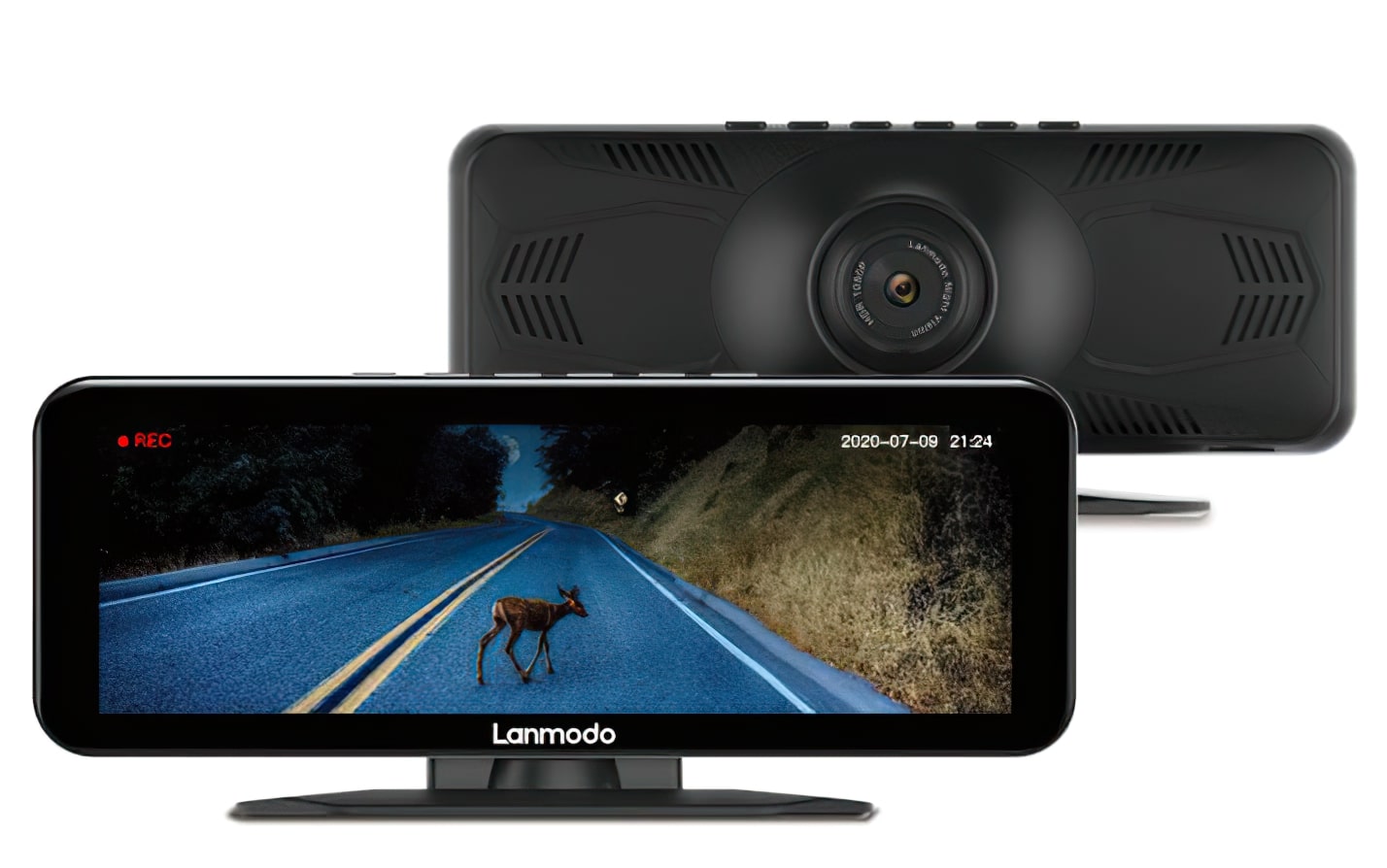
The Asus ROG Zephyrus Duo 15 is sort of probably probably the most ludicrous gaming laptops I’ve ever come throughout. Specs-wise, it has all of the bells and whistles you possibly can probably need. There’s a brand-new 10th Gen Intel Core i9 processor in right here, together with an enormous 32GB of RAM, an RTX 2080 Super Max-Q graphics chip and a pair of 1TB NVMe SSDs RAIDed collectively to type one monumental 2TB storage financial institution.
Normally, the specs alone would have been sufficient to place it squarely in ‘overkill’ territory, however that’s not even the tip of this mad iceberg. On prime of all that, this laptop computer has not one, however two screens, and is without doubt one of the first dual-screen laptops to make its strategy to the UK (with a US launch to observe shortly). The first is a reasonably conventional 15.6in 4K IPS panel with full-fat Nvidia G-Sync assist. The different is a thin 14.1in 3840×1100 touchscreen that rises up from the highest of the keyboard routinely as quickly as you open the lid. It is, briefly, bonkers. Best of all, Asus need a cool £4000 for it.
It’s sufficient to make you throw your arms up and simply flat out stroll away, isn’t it? I ought to notice, in fact, that that is essentially the most highly effective variant of the Zephyrus Duo 15. There’s additionally a barely cheaper RTX 2070 Super mannequin with an older ninth Gen Core i7 CPU and simply 1TB of storage out there for a nonetheless very sizeable £3000, and each fashions have the choice of swapping out the first 4K show for a 1920×1080, 300Hz refresh price panel as a substitute (though I’ve but to seek out them in inventory wherever to see how a lot they value).
Asus ROG Zephyrus Duo 15 evaluate in a nutshell
The good…
- Main show has a brilliant correct IPS panel
- Loads of ports
- Wrist relaxation is included within the field
The unhealthy…
- The secondary touchscreen is sort of grainy
- Only actually match for 1080p gaming
- Secondary show has restricted use
- It’s loopy costly
Even so, the entire notion of it stays mildly preposterous. It’s precisely the form of fever dream that appears destined for the ‘more money than sense’ finish of the tech spectrum, and in some ways, the 4K mannequin I’ve examined right here 100% falls into that class in case you view it purely as a high-end gaming laptop computer.
It may need a brilliant quick Intel Core i9-10980HK processor, 32GB of RAM and an RTX 2080 Super Max-Q graphics chip at its disposal, however the Zephyrus Duo 15 just isn’t lower out for 4K gaming. It can handle a gentle body price on Medium settings in most of at the moment’s prime games at this decision, however even then you definitely’re largely taking a look at someplace between 40-50fps moderately than a clean 60fps. That’s lots decrease than what I might count on for a graphics chip of this calibre, as I’ve seen common RTX 2080 laptops obtain a lot quicker speeds than this, typically hitting near 60fps on Medium and 40-50fps on High.
Instead, this can be a laptop computer the place you’ll should make do with a 1920×1080 decision if you wish to play at 60fps on the highest graphics settings. Indeed, you don’t even get the posh of choosing a decision of 2560×1440 with the Zephyrus Duo 15, as not one of the games in my benchmarking suite would even give me the choice of taking part in at 1440p, presumably as a result of it was getting a bit confused with its secondary show.
Instead, I needed to make do with 1080p, however even then there have been nonetheless some niggling points. In Shadow Of The Tomb Raider, for instance, I recorded a median body price of 65fps on Highest with its prime SMAAx4 anti-aliasing setting enabled at 1080p, however I needed to allow the game’s DLSS assist if I additionally wished to take care of that form of velocity with its prime ray tracing setting switched on.
Final Fantasy XV additionally managed a clean common of 71fps on Highest at 1080p with all of its further Nvidia results disabled, however I used to be stunned to see that determine drop to 54fps once I turned on its HairWorks and Turf Effects settings. That’s nonetheless eminently playable, I would add, however I might have anticipated an RTX 2080 Super chip to supply a bit extra energy at this sort of decision. As for switching on all of the game’s further Nvidia results, you’re taking a look at a median of 45fps in case you stick to Highest, which isn’t actually what you need from a £4K 4K machine.
That stated, even when there weren’t any further demanding settings to deal with, the Zephyrus Duo 15 nonetheless struggled to hit a clean 60fps on maxed out settings in among the different games in my testing suite. In each Assassin’s Creed Odyssey and Metro Exodus, for instance, it solely averaged 55fps on max settings, and I needed to drop right down to the subsequent preset to hit that all-important 60 mark.
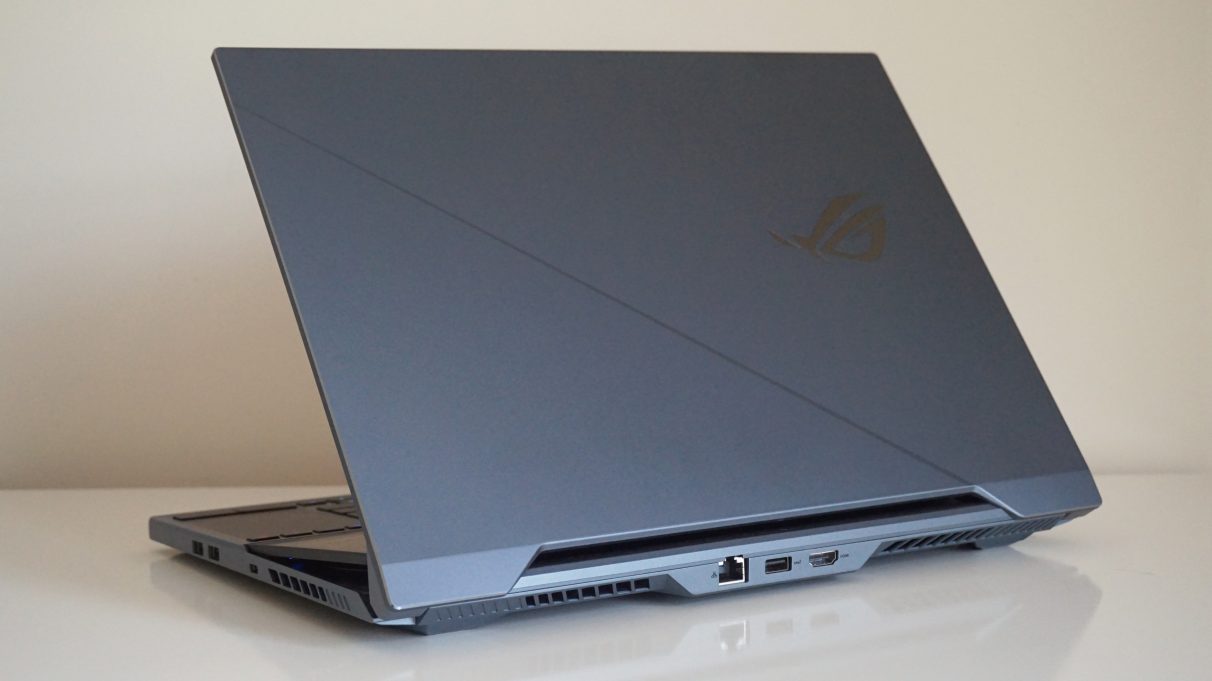
The beauty of the Asus ROG Zephyrus Duo 15 is that you just don’t realize it’s a gaming laptop computer.
It fared higher in Monster Hunter: World, the place it produced a silky common of 67fps on Highest at 1080p once I was out roaming via its jungle panorama, and it dealt with The Witcher III prefer it was nothing in any respect, averaging 82fps across the forest of White Orchard on Ultra. Total War: Three Kingdoms additionally returned a median of 60fps on Ultra at 1080p, which rose to a a lot smoother 82fps once I dropped the settings right down to High (not that you just’ll get the advantage of these further 20 frames on the 4K mannequin, because the refresh price of the primary show is restricted to 60Hz).
As for bumping these resolutions as much as 4K, I used to be solely in a position to handle round 40fps on Medium high quality in all the games talked about above, and even Monster Hunter: World’s DLSS assist solely pushed that as much as round 50fps on Mid at finest. As a outcome, it appears completely mad to shell out a lot extra for a 4K show when you possibly can’t make full use of it. Instead, the 300Hz 1920×1080 variant would seem like the vastly superior possibility right here, because it’s merely not sensible to go for something increased.
It’s not just like the 1080p show is considerably worse than the 4K one, both. Both have full-fat G-Sync assist to assist remove issues like stutter and screen-tearing, they usually’ve each been validated by the color consultants at Pantone, in line with Asus, so they need to be of similar high quality. Indeed, once I examined the 4K mannequin with my X-Rite DisplayProfessional i1 calibrator, it returned an ideal rating of 100% sRGB gamut protection and a powerful 88% protection of the HDR-grade DCI-P3 color gamut. This isn’t an HDR show, I ought to add, as its peak brightness solely tops out at 371cd/m2, however whenever you mix it with a low black degree of 0.27cd/m2 (the nearer to 0.00cd/m2, the higher) and a excessive distinction ratio of 1347:1, it nonetheless means you get tremendous vivid and vibrant colors that basically make your games sing whilst you’re taking part in.
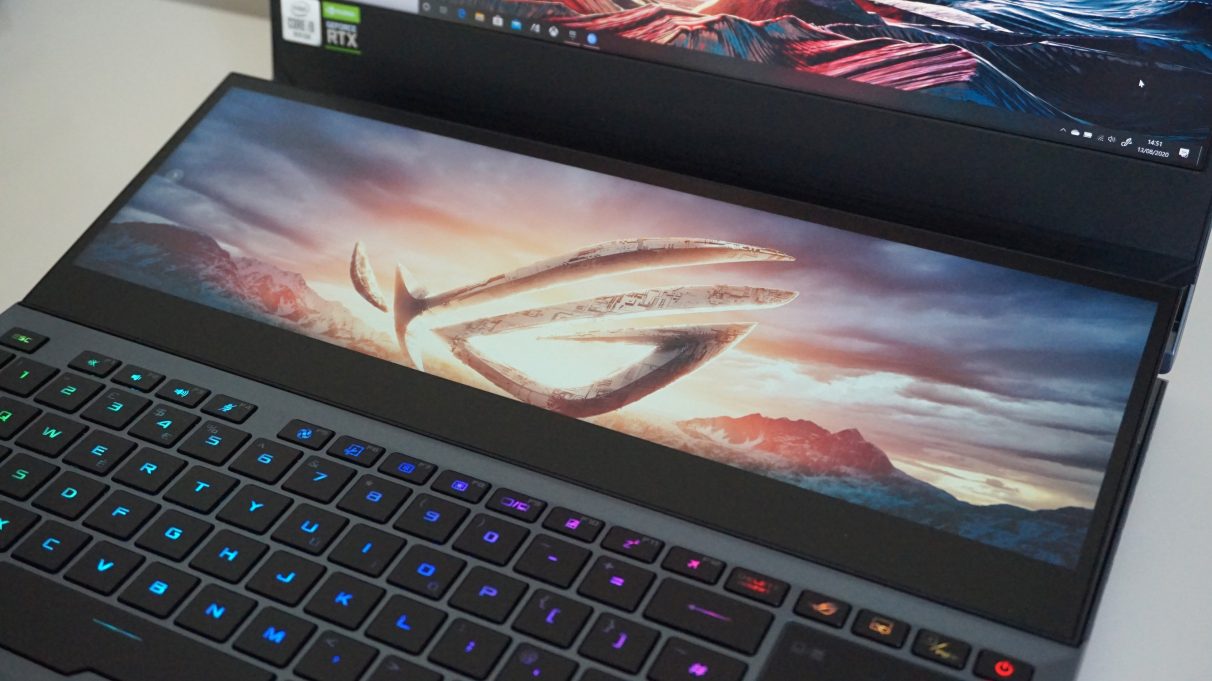
The second show works in precisely the identical approach as having a second monitor. It extends your desktop, and you need to use it to maintain tabs on different purposes whilst you’re gaming or doing different duties on the primary display.
Or a minimum of it could if the followers weren’t fairly so noisy. I hoped that the additional two followers tucked away below the secondary touchscreen would possibly assist the Zephyrus Duo 15 in its efforts to maintain cool below load, however alas, it could appear it’s similar to each different gaming laptop computer on this respect: good and quiet when idle, however a veritable jet engine whenever you’re doing something extra taxing.
The RGB backlit keyboard will get highly regarded, too. Not a lot that it melts your fingers in case you’ve received them glued to the WASD keys whenever you’re taking part in games, however the Tab, Caps Lock, Shift and Esc keys all felt dangerously toasty once I was benchmarking. It additionally takes some time to get used to having it shunted up to now down in comparison with different laptops, however the excellent news is that Asus have thought forward on this regard and included a cushty, rubbery wrist relaxation to assist make typing a bit simpler on the outdated wrists.
At first, I felt very hesitant typing on the Zephyrus Duo 15. The keys weren’t fairly the place I used to be anticipating them to be, and the shut proximity of the left-hand Shift key to its neighbouring key typically meant I used to be perpetually making errors when typing rapidly. Still, inside a few hours of utilizing it, I used to be kind of again as much as my common typing velocity, and I ultimately received used to every key’s small however tactile quantity of journey. The wrist relaxation helped lots, too, and shortly it didn’t even happen to me that the keyboard was in a unique place in comparison with my on a regular basis Dell XPS 15 laptop computer.

You can flip the touchpad right into a makeshift quantity pad by holding right down to the button within the prime left nook of it.
I additionally had no complaints in regards to the Zephyrus Duo’s Intel Core i9-10980HK processor. Yes, it’s large overkill for a gaming laptop computer, however with Cinebench R20 scores of 485 within the single core check and 4143 within the multicore check (the latter of which comfortably beats its ninth Gen predecessor by round 800 factors), I’m actually not complaining.
The identical goes for its 2TB SSD. Not solely is that loads of storage for putting in all of your favorite games, however its random learn and write speeds are additionally completely prime notch. In AS SSD’s 1GB 4K random check, for instance, which randomly reads and writes 1GB’s price of tiny 4K recordsdata to simulate the form of duties you do daily in your laptop computer, the Zephyrus Duo 15 managed a really spectacular 44MB/s learn and 109MB/ write, the latter being one of many quickest speeds I’ve ever seen on a gaming laptop computer.
As for that secondary show? It is beneficial at occasions, and I like the very fact it’s a touchscreen, too, because it means you possibly can simply scroll via your emails, skip tracks on Spotify and usually navigate an online web page with out having to Alt-Tab out of your game. Its 3840×1100 decision and tremendous skinny facet ratio don’t go away you a lot room to manoeuvre, admittedly, however of all of the dual-screen laptop computer designs I’ve seen up to now (a few of which jam it into the touchpad, others right into a smaller, extra centralised show above the keyboard), that is positively the most effective implementation of it.
It works precisely like having a second monitor hooked as much as your laptop computer. The desktop is of course prolonged downwards, and you may simply drag and drop home windows and tabs onto it from the primary show. There’s an Asus overlay app that allows you to change the touchscreen’s brightness, decision, scaling choices and default window dimension so apps can take up a 3rd, half or the complete width of the display, and you may as well use it to launch purposes as effectively. All it’s essential to do is drag and drop your desktop shortcuts into the app’s launcher tab.
The factor is, it’s additionally received fairly a grainy end that makes it look a bit low-cost – like these very early touchscreen Windows 10 tablets that began showing in 2016. Combine this with the low angle of the touchscreen, and it finally ends up wanting a bit dim and hazy – not the type of factor you’d count on given the general value of the Duo 15, or the highest notch high quality of the primary show.
It’s a disgrace, because it form of put me off utilizing it – and I say this as somebody who’s always craving for a second display each time I’m away for work (ah, these have been the times), and who positively hates it each time I’m pressured to juggle a number of issues on a single show. I’m so on board with the concept of dual-screen laptops, so it was disappointing to see that it wasn’t of the identical form of high quality as the large fundamental show.
Maybe I’m simply asking an excessive amount of of the Zephyrus Duo 15 proper now. After all, it already prices 4 grand as it’s, and I hate to consider how way more it could be if it had a better high quality touchscreen. Then once more, what’s one other couple of hundred quid once we’re already within the realms of foolish cash anyway? It’s arduous to say. It’s not like anybody of their proper thoughts ought to really purchase this laptop computer, in any case. Its worth and specs are large overkill for what successfully quantities to a really succesful 1080p gaming laptop computer, and the novelty issue of that second display rapidly wears off when all you possibly can see is its grainy end.
I like that the Zephyrus Duo 15 exists, and I do very a lot hope it results in extra dual-screen laptops sooner or later. But this isn’t the dual-screen laptop computer you have to be shopping for proper now, and positively not the one you have to be attending to play games. If you’re completely determined for it, get the cheaper 300Hz 1080p mannequin as a substitute, because the 4K one will doubtless solely result in disappointment.
